The key to making a delicious Sidecar cocktail is the balance of flavors. Carefully selected ingredients and the ideal ratios will get you one of the finest classic sour cocktails out there. It's elegant and refined without being pretentious or overly complicated.
Quick Facts Sidecar Cocktail
So let's take a closer look at the Sidecar Cocktail, its history, and how to make it extra delicious.
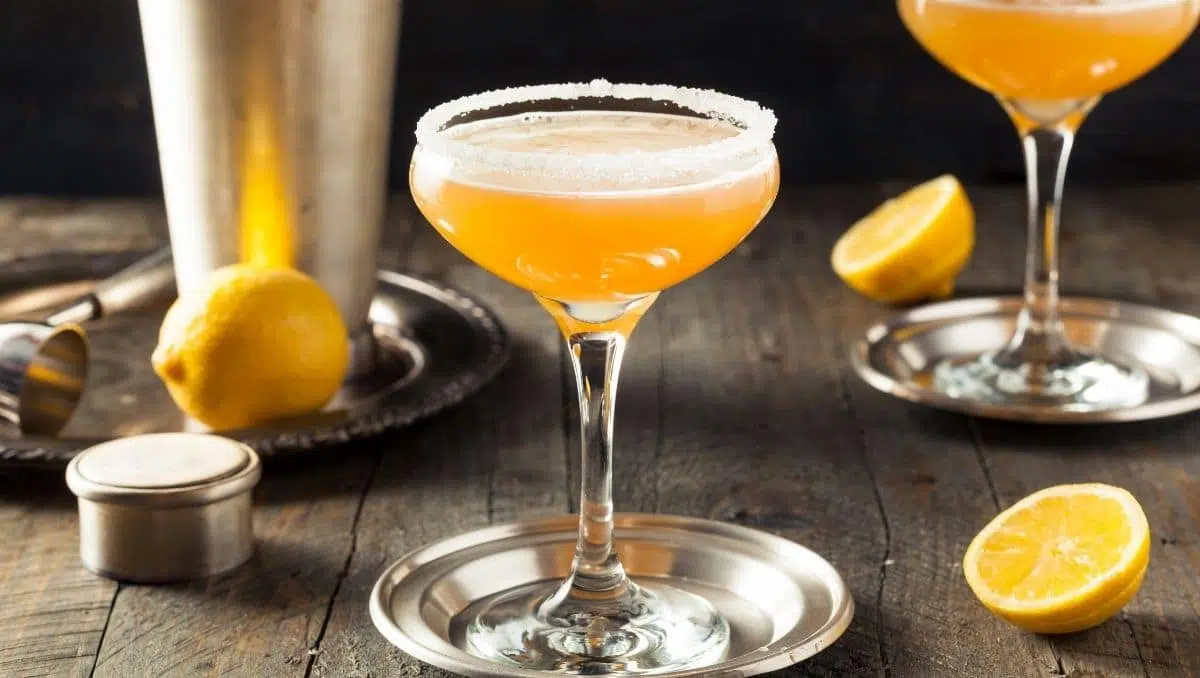
The Sidecar belongs to the group of cocktails made of only three ingredients. The right mix of brandy, triple sec, and lemon juice are enough to create something outstanding:
Traditionally the Sidecar is made with expensive luxury Cognac. However, the beauty of this cocktail is that it really doesn't require one of the crazy expensive bottles. We even found that Cognac in the medium price range works better with this recipe.
Still, cognac, in general, is a premium spirit and doesn't come cheap. We like the V.S.O.P. from Remy Martini ($70 - $75) or the V.S. from Hennessy ($60) - both favourites among many fellow bartenders as well.
If you're not familiar with these terms, here's a short guide. Depending on the age, you can categorize cognac as:
Cognacs of the X.O. category can be very expensive. Be prepared to pay around $200 or more for a good bottle.
But again, for the Sidecar drink, a V.S. or V.S.O.P. is absolutely sufficient. Why? Extensively aged, top-shelf cognac displays a nuanced aroma that gets lost in cocktails. It would simply be a waste of money.

A sugar rim is optional and not strictly necessary for balancing the flavors. Nonetheless, it is a common way to serve the Sidecar Cocktail, and I like that bit of sweetness with this otherwise dry drink.
We recommend superfine sugar. It sticks well to your glass, and you will swallow less of it while drinking. If you're using regular granulated sugar and add too much, your sugar rim might make the cocktail too sweet.
To get the rim right, moisten the outside of your glass with a juicy lemon wedge and gently dip the glass into sugar. Try only coating the outside because you don't want the sugar to fall into your cocktail. Also, make sure to use fine-grained sugar.
For achieving a delicious Sidecar, the right balance and ratio are crucial. Many recipes use two parts of cognac, one part lemon juice, and one part triple sec. While this works fine, we prefer a slightly different approach with a little more emphasis on the cognac.
Either way, you should use plenty of ice when prepping this drink and shake for no less than 10 seconds to achieve the required dilution from the melting ice. The recipe is quite boozy. Hence, you need that for the right balance.
Since the drink is served straight up, we also recommend chilling your glass; either in the freezer or with some ice cubes, which you discard before pouring your Sidecar.
There are plenty of riffs and variations on the Sidecar recipe. The most obvious approach to experiment with the drink would be using another type of brandy.
The possibilities are endless, and your could start by trying a Cherry Brandy like older recipes recommend or Pisco to get a sweeter version.
Another option is to add a bit of syrup, especially when you don't want to apply sugar to the rim of your glass:
Some might feel the traditional recipe is too tart for your taste buds. In these cases, a couple of drops of syrup work a treat in adjusting the balance of the Sidecar. Besides the obvious choice of simple syrup, you could try Demerara syrup for a richer taste.
And don't forget: when you opt for syrup, drop the sugar rim in turn.
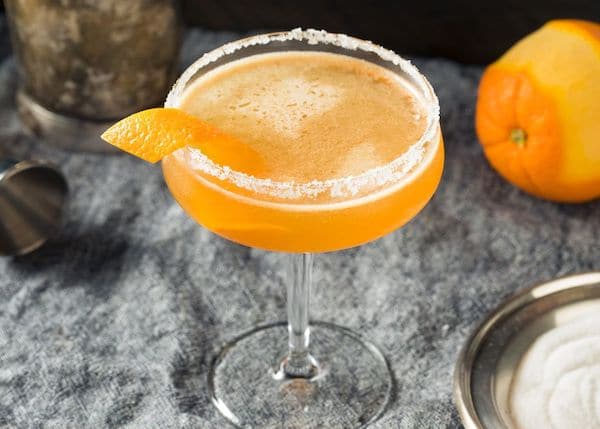
The history of the Sidecar Cocktail is pretty hazy. There are multiple stories on how, when, and where it most likely got invented. What all these accounts have in common, though, is the time frame, which was around World War I, between 1914 and 1918.
One of the more likely tales of the origin says that the Sidecar drink got invented in a Bistro in Paris, France. You can find this story in David Embury's "The Fine Art of Mixing Drinks" published in 1948.
Then there's another claim from Paris, more precisely from the Ritz Carlton hotel bar. That version names Frank Meier as the inventor of the cocktail that we know as the Sidecar today. - By the way, a special Sidecar at Ritz Paris, made with cognac from the mid-1800s, is among the 5 most expensive cocktails worldwide.
Other sources throw in Buck's Club in London or the famous Harry's New York Bar in Paris as possible birthplaces of the sophisticated brandy cocktail.
As for many other classic cocktails, it is impossible to tell which of the many stories is closest to the truth.
There are two different versions of how the Sidecar cocktail got its name:
The first version is David Embury's story of the Parisian Bistro that supposedly created the first Sidecar. It says a man who came to the Bistro in the Sidecar of a motorcycle invented the drink.
Veteran bartender Dale DeGroff has his own theory. He claims the name refers to the mix left in the cocktail shaker. - Strained and served in a shot glass, this additional drink is a metaphorical sidecar of the actual cocktail.
If you're looking for more brandy cocktails you can easily mix at home, check out these recipes:
Frangelico is a sweet Italian hazelnut liqueur with an alcohol content of 20% (40 proof). The liqueur is based on a hazelnut infusion and flavored with cocoa, roasted coffee, and vanilla flavors. Just like the taste, the aroma is full of rich roasted hazelnut notes with complementing chocolate and vanilla notes.
The most common way to drink it is neat as a shot, but you can also use it in cocktails. Here, Frangelico is typically used to impart rich nutty flavors into drinks.
The bottle design of the liqueur is as unique as its taste. It resembles the shape of a monk's habit and even has a rope tied around its waist.
It's truly is one of my favorites and one of the nuttiest liqueurs you can get. So here is all you need to know about Frangelico.
What is it? | Facts | How does it Taste | How to drink | Substitutes | What pairs well | How it's produced
Frangelico is an Italian hazelnut liqueur made from Piedmont. In Europe, it has been a well-liked après-ski shot after a day on the slopes for decades. But these days, you can find it in all parts of the world, in almost every well-stocked professional bar.
The reason is simple, Frangelico has a rich, distinct, and, above all, unique and intense nutty taste. You will hardly find a comparable product that works as a substitution.
The bottle design of the Frangelico liqueur is as unique as its taste. It resembles the shape of a monk's habit and even has a rope tied around its waist.
The brand was established in 1978, yet, the recipe seems to be much older. The original version of the liqueur is said to have been invented during the 17th century by monks in the Italian Piedmont region. Supposedly, it was also named after a hermit monk called Fra' Angelico, who had lived in the hills of Piedmont at the time.
Frangelico tastes delightfully sweet and rich and has a distinct flavor of roasted hazelnuts with notes of vanilla, coffee, and cocoa. The sweetness is well-balanced, and you get a subtle but pleasant burn from the alcohol.
Frangelico is 100% one of the most hazelnut-forward liqueurs you can find. I would go so far as to say it is the liqueur with the most intense hazelnut flavor out there. At least, to date, I haven't come across something similar.
The nicest way is to drink Frangelico neat as a shot with a real hazelnut in the glass. You can serve it chilled out of the fridge or at room temperature. -Both work superbly in this case. I prefer chilled, though, as this covers some sweet notes. The sweet and nutty flavor makes it perfect for winter drinks like hot chocolate, hot milk, or spiked cappuccino.

At the same time, Frangelico is also a pretty versatile cocktail ingredient. Especially full-bodies spirits like Whiskey or Brandy are an excellent match for the nutty, rich flavor of the liqueur. However, it also works beautifully in combination with creamy and chocolatey ingredients.
You can find Frangelico in various dessert cocktails. Plus, it can be used as a nutty element to get the typical peanut butter & Jelly combination in liquid form.
The best substitute for Frangelico is Toschi Nocello, an Italian nut liqueur made of walnuts and hazelnuts. It comes reasonably close to Frangelico when you mix it into cocktails. Other alternatives include DeKuyper Hazelnut Schnapps and Bartnenura hazelnut liqueur. However, the hazelnut flavor and aroma are nowhere near as intense as in Frangelico.
I recently discovered another excellent alternative for Frangelico from the North Italian brand Walcher; -It's called Noisetto. Noisetto is a liqueur based on rum flavored with roasted hazelnuts that originate from the same region as the ones in Frangelico, Piedmont. It's superbly nutty with a delicate rum note. The only downside is that it's hard to get.
In rare cases, you can use Amaretto as a replacement, preferably when used in baking recipes. In cocktails, I would always prefer another hazelnut liqueur over Amaretto. But let me explain.
Some people confuse those two products because, presumably, both are made from nuts. -One from hazelnuts, the other from almonds. Well, without wanting to be too nitpicky here, almonds are fruits, not nuts.
However, more importantly, Amaretto gets its almondy taste from stone fruits like peaches, not almonds.
Frangelico offers an intense and wide array of warm notes from hazelnuts, cocoa, vanilla, and coffee. The taste of Amaretto is more one-dimensional. It is also sweet but more reminiscent of marzipan. Both liqueurs are delicious, yet in very different ways.
| Frangelico | Amaretto | |
|---|---|---|
| ABV | 20% | 21% to 28% |
| Proof | 40 | 42 to 56 |
| Taste | Sweet, hazelnut, cocoa, vanilla | Sweet, marzipan, almond, vanilla |
| Color | Amber gold-colored | Darker, reddish amber color |
| First created in | 1978 | 1525 |
| Price | $30 | $30-40 |
The rich nutty flavors of Frangelico pair extremely well with coffee, berry flavors, Irish Cream, and other milk-based drinks. In some cases, it even pairs well with acidity like in a Frangelico Sour recipe. To make this drink, you need:
Instructions: Add all ingredients (except ground hazelnuts) into a cocktail shaker and dry-shake without ice for 15 seconds. Open the shaker, add ice, shake again for 8-10 seconds before straining into a Coupe glass, and garnish with ground hazelnuts.
The production process is comparable to that of other liqueurs. Crushed and toasted hazelnuts from the Piedmont region build the base left to soak in a solution of alcohol and water.
The resulting infusion gets distilled and then blended and flavored with extracts from cocoa, roasted coffee, vanilla, etc. Of course, the formula is a well-kept secret.
To finally achieve bottle strength, the distillate is watered down and sweetened. Before bottling, the liqueur needs to rest for six to eight weeks to allow all flavors to blend. That's when the iconic rich and intense hazelnut taste of Frangelico develops.
Frangelico is an absolutely delicious liqueur made of the finest hazelnuts in Italy. It might not be the most famous liqueur, but it certainly is among the best ones I've tried.
If you haven't had the chance to try Frangelico yet, do so during your next visit to your favorite cocktail bar. I'm sure it won't disappoint. Also, if you're looking for a drink featuring the beautiful hazelnut liqueur, try the Hazelnut Sour from our favorite Thanksgiving cocktails.
Everyone has heard of it, but only a few know how to make it - the Singapore Sling Cocktail. It's hardly surprising when you look at the long list of ingredients, including gin, different liqueurs and juices, soda, red wine, and bitters.
So, time to get your shaker out and make our favorite version of the Singapore Sling.
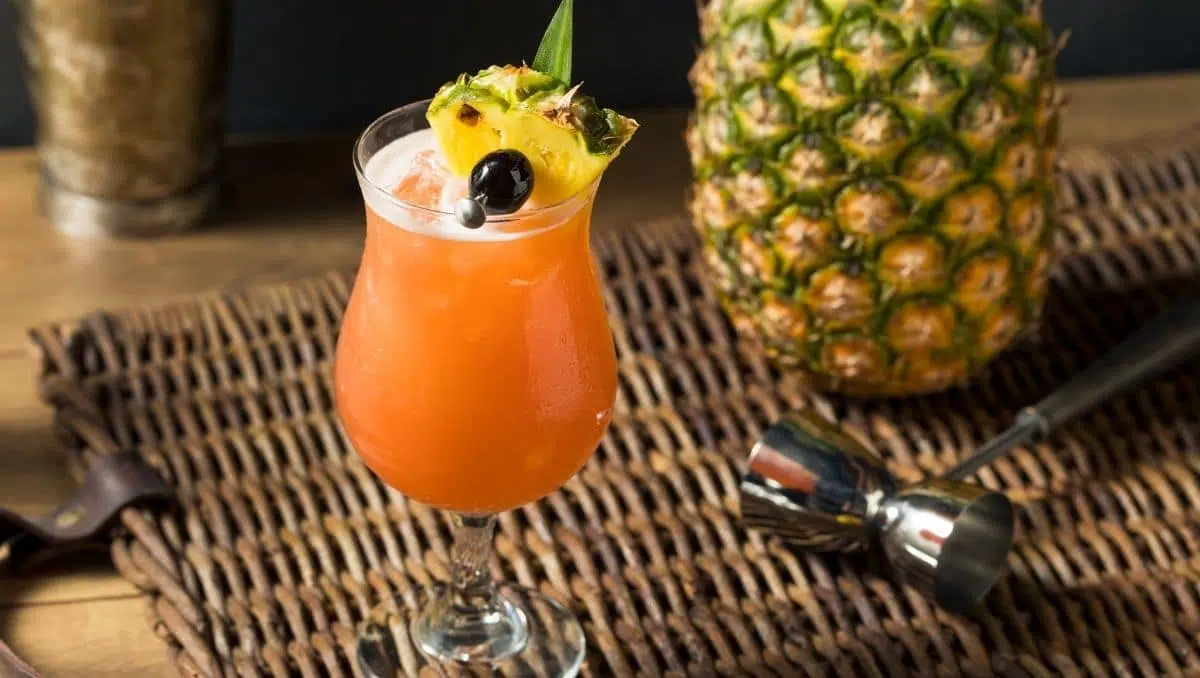
The list of ingredients required for the Singapore Sling recipe is long - and that goes for every version of this cocktail. So, making this iconic drink needs some determination and these nine ingredients:
Despite the long list of ingredients, you should still pay attention to a few details with this recipe. That means you definitely should opt for freshly squeezed juices.
It is a given for drinks with only a few ingredients, but you may feel tempted to cut a corner and use bottled juice. However, I recommend not to. With grenadine and Heerings, you have enough added sugars in your drink. The tangy, natural flavor of fresh juice will lift your Singapore Sling.
Talking about grenadine: if you have time to make the syrup at home, do that. Even though only a small amount goes into this drink, it makes a difference. -And you can use it for other recipes too.
Further, floating the red wine on top works best when you pour slowly and gently over the back of a bar spoon. -And one last tip regarding the soda water: Use a new bottle or one you opened only recently to make sure it has enough carbonation.
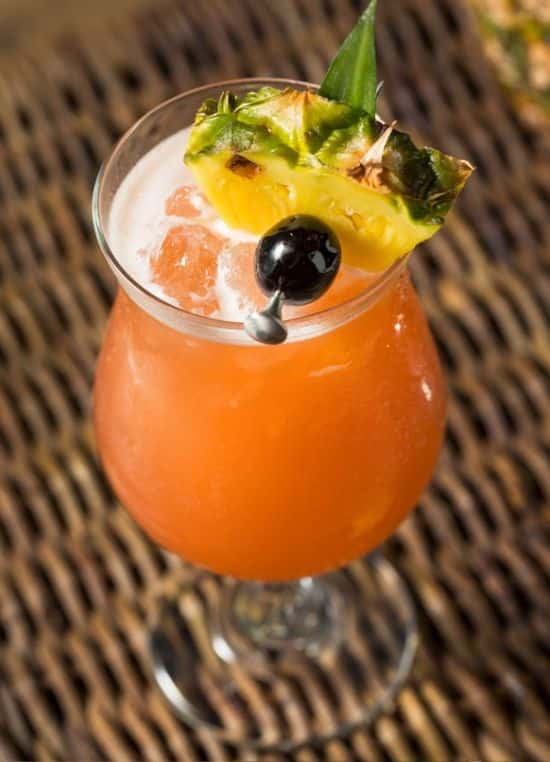
The Singaporean Raffles Hotel is considered the home of the Singapore Sling. Yet, when you take a look at the current menu at their Long Bar, you quickly realize that they have not only one recipe but two.
The first is a more traditional take on the Singapore Sling, named The Raffles 1915 Gin Sling. The other is a contemporary variation with the descriptive name Modern Raffles Singapore Sling.
If you want to try them at home, you need to stock up on some unconventional supplies. Anyway, here are the ingredients and measurements for the versions served at Long Bar:
The Raffles 1915 Gin Sling
Modern Raffles Singapore Sling
The legendary drink likely originated in Singapore's famous Raffles Hotels, where Chinese bartender Ngiam Tong Boon supposedly invented it over 100 years ago, in 1915, while working at the bar in said hotel.
Since then, the recipe got published in various cocktail books, each featuring a different version. Why? Because the original recipe from Raffles Hotel got lost. Consequently, nobody knew how Ngiam Tong Boon prepared the drink and which ingredients he did use.
Thus, you will have a hard time finding two bars serving the same version of the Singapore Sling these days. We tried quite a few, and the recipe above turned out to be our favorite.
By the way: the term sling is derived from the German word schlingen, which means to gulp down.
Even though most experts agree on this story of Raffles, there are hints that it might now be the entire truth. When looking closely into the history of the Singapore Sling, you come across some different theories.
On searching the Singaporean newspaper archives, David Wondrich found that the first reference to a Sling was from 1897. That would have been almost 20 years before Boon mixed the cocktail at Raffles for the first time in 1915.
In 1903, another statement seemingly referred to the drink as "pink slings for pale people." It states the pink hue the Singapore Sling is famous for and points out that the recipe was meant for Western tourists.
And finally, an article from 1913 states the typical components of the Sling cocktail. The ingredients included: cherry Brandy, D.O.M. Bénédictine, gin, lime juice, ice, a few drops of cocktail bitters, and water. What's more, it seems that, occasionally, a red wine float was part of the mix.
Despite all this, the Raffles Hotel is widely considered the birthplace of the Singapore Sling, and many bars and bartenders took a cue from their recipe.
If you're into vintage boozy, classy drinks, the Hanky Panky cocktail is a good choice. The complex mix from the early 1900s combines three herbal components: gin, sweet vermouth, and the Italian Fernet Branca.
Gin with vermouth is a proven concept. They work well together, as we know from the classic Negroni. But the highlight of this cocktail is the addition of just the right amount of Fernet Branca. Its herbal notes bring a fine complexity to the drink.
So now, let's look at how to make this high-ABV cocktail and find out how the Hanky Panky got its unusual name.

Gin, sweet vermouth, and a bit of Fernet Branca, that is all it takes to make an amazing Hanky Panky cocktail. But what types of gin and which vermouth work best?
More about Fernet: Like Campari, Fernet Branca's roots lie in Milan, Italy. It is an amaro herbal liqueur infused with 27 different herbs.
The complete formula is a well-kept secret, but we know it contains various ingredients from all across the globe: Gentian from France, Galangal from India, Rhubarb from China, and Chamomile from Argentina are just a few of them.
It also contains a whopping 39% of alcohol, making it a second high-proof component in the Hanky Panky recipe. Apart from this cocktail, the flavorful Italian bitter is especially popular in Argentina. The Argentinians even make their unofficial national drink on it, the Fernet Coca.
The Hanky Panky is a cocktail you prepare stirred in a mixing glass. You do not shake it. For those new to mixology, I want to explain quickly why that is important when preparing this drink:
Stirring with ice will generally cause less dilution than shaking with ice does. The Hanky Panky cocktail is a drink you want to water down as little as possible to receive the best result. That is also why a stirred drink usually isn't served with ice.
Now, if you wonder, why not prepare it in the glass? First, because you still want your drink to be nicely chilled. So, you will need ice when making it. And second, you need to mix the ingredients properly, which won't be easy in a small Nick and Nora glass.
To create variations of the original Hanky Panky recipe, you can start experimenting with ratios. Some like their drink even drier and boozier, increasing the amount of gin to 2oz and Fernet to 1/4 oz.
As mentioned above, if you want your drink a tad less dry while keeping its integrity, keep the ratios but replace dry gin with the slightly sweeter Old Tom Gin.
Alternatively, you can also try one of these related drinks, all with gin, sweet vermouth, and a herbal liqueur:
The history of the Hanky Panky recipe begins in the early 1900s with Ada Coleman, the inventor of the drink. She was a famous bartender, working at the American Bar in the Savoy Hotel in London. Perhaps the name rings a bell? It is the bar where Harry Craddock worked, author of the world-famous Savoy Cocktail Book.
Back to Ada, or "Coley", as her regular guests called her. During the early 1900s, she often served drinks to Charles Hawtrey, one of the best cocktail jurors at the time.
Once, he asked her for a drink "that packs a punch". Coley spent hours experimenting and developing a new recipe. And when Charles stopped by the next time, she greeted him with her latest creation.
The cocktail allegedly got its name from mentioned juror Hawtrey. You may know that many drinks have unusual names, but Hanky Panky seems next-level unconventional.
The story goes that he first took a small sip, then emptied the whole glass in one big gulp. When he put the glass back on the counter, he exclaimed, "By Jove! That is the real hanky-panky!". That's how the cocktail got its name.
When done right and with the right ingredients, the Piña Colada Cocktail is a pure delight. However, it frequently gives cocktail lovers a hard time. Way too often, you get something heavy and overly sweet. So let's change that.
Once you have tried a proper recipe, you will find that this Tiki cocktail is actually sensational.
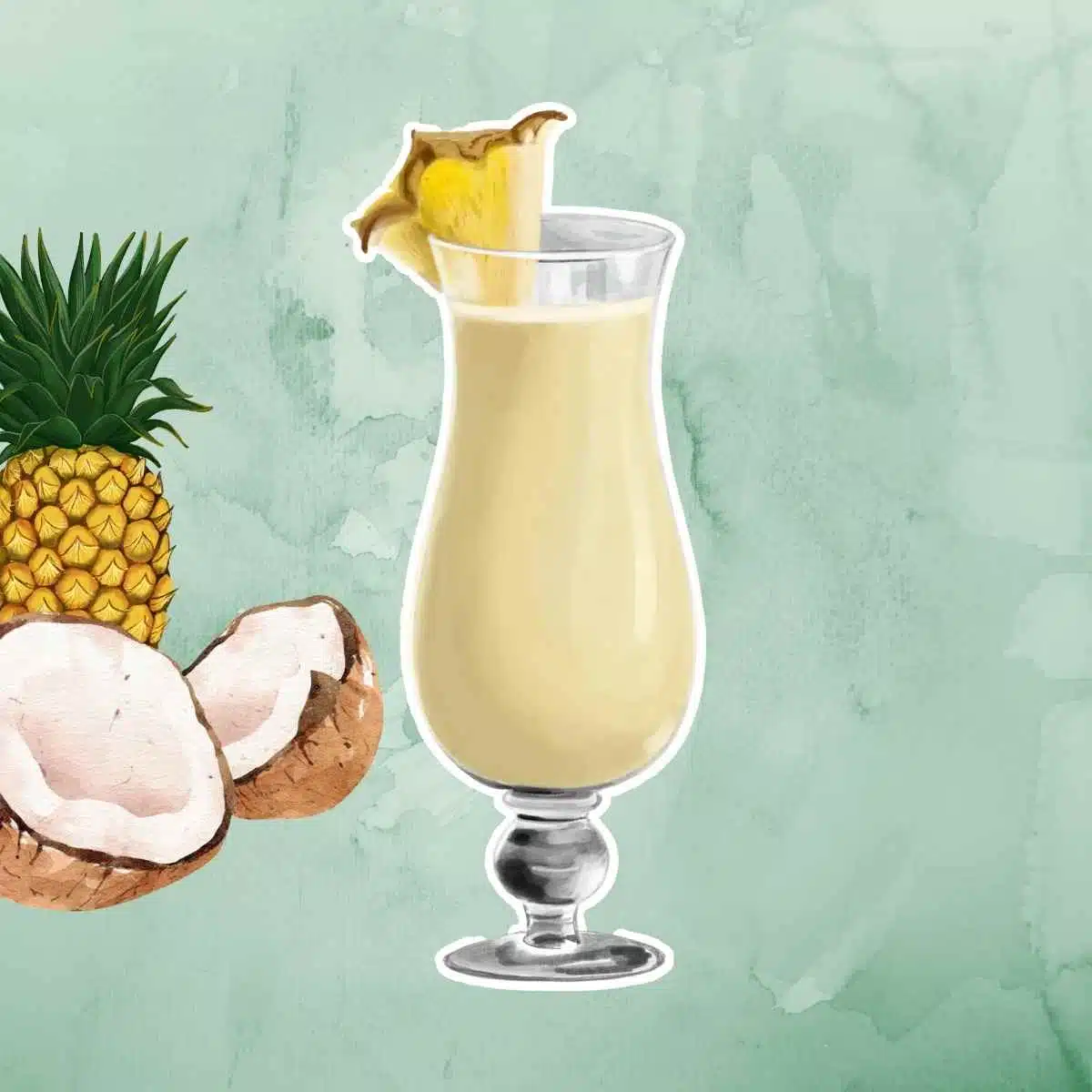
The crucial part of making an excellent Piña Colada is the choice of ingredients. That means fresh and quality products and the right coconut product:
The secret key to a perfect Piña Colada is cream of coconut - not coconut cream. That sounds like not much of a difference at first. But it is absolutely vital.
Using coconut milk or coconut cream won't work. But don't despair if you cannot find it in your supermarket. You can easily make it at home with this cream of coconut recipe.
For the fruity ingredients of this Piña Colada recipe, lime, and pineapple, I strongly recommend getting both fresh and juicing them a couple of hours before mixing the cocktails.
Further, you can see that our recipe asks for pineapple juice and frozen pineapple chunks. For this, cut half of the fresh fruit into small squares, and store them in the freezer until it's time to put them in the blender.
The pieces should be small enough, so your blender can handle them when frozen. Then take the remaining bits of pineapple to make freshly squeezed pineapple juice.
Additionally, I use a base of white rum and float the blended cocktail with aged dark rum for a more complex taste. My favorites are Havana Club 2 Years for the base and Havana Club Añejo Especial for the float- both from Cuba.
If you're in the US, you won't be able to get those, I can recommend Bacardi for the base and Diplomatico Reserva for the dark rum.
The question might as well be: classic or modern? The short answer is: both ways work and deliver exquisite results. While the traditional recipe asked for blended Piña Coladas, the new wave made it a shaken cocktail.
Nevertheless, I prefer the blended version with quality ingredients. I'm often a traditionalist when it comes to cocktails, and it's no different here. I think the float looks nicer, it has a better texture, and the consistency is super smooth and silky when using a blender.
So, when it comes down to it, it is more a question of personal taste and whether you prefer classic practices. Yet, with our recipe, blending your Piña Colada delivers the best results. If you want to use a shaker, you should slightly adjust the measurements.
The Piña Colada recipe offers a few options for tweaks, even if the original is already pretty amazing:
The Pina Colada Recipe dates back to the 1950s. It was invented in a hotel bar on the Caribbean Island of Puerto Rico, from where it conquered North America and became part of the modern Tiki culture. Today, this tropical drink is a global household name.
If you want to know the whole story, read the entire history of the Piña Colada here.
You want to mix up more tropical rum cocktails at home? Try some of our favorite recipes:
Cream of coconut is the key ingredient to turning an average Piña Colada into a true masterpiece. Yet, depending on your location, it is not always easy to get as only a few brands produce and sell it.
But don't worry, here's an easy recipe to make an excellent version of creme of coconut that can keep up with the product from Coco Lopez - one of the most famous brands.
You don't need artificial ingredients like emulsifiers, polysorbate, alginate, and the stuff store-bought products usually contain. You can easily make a sensational homemade cream of coconut with our recipe. All you need is coconut milk, sugar, and a pinch of salt. These all-natural ingredients make it even better than the store-bought versions.

You don't need a lot of elements to create this tasty cocktail ingredient. And the ones you do need are pretty easy to get and affordable.
Quality coconut milk with around 10 - 15 % of fat, granulated sugar, and a pinch of salt is all you need to get this right. Regarding coconut milk, I like to use Aroy coconut milk from Thailand, but if you have a favorite brand that fits the brief, stick to that.
For the sugar part, you can stick to regular white granulated sugar. There's no need to shop for anything fancy, as the coconut is the sole star of the show.
If you now wonder why you cannot just use coconut cream as a substitute or at least use that for our cream of coconut recipe, read on to find out.
Let's quickly talk about the difference between cream of coconut and coconut cream:
They are two different products used for different purposes. You can not simply replace cream of coconut with canned coconut cream. The texture won't be right. The sweetness level won't be right. Thus, the result will be miles away from how it is supposed to taste.
If you want to know more, check out our article comparing cream of coconut vs. coconut cream.
That still leaves us with the question of why you should not use coconut cream as a base for our recipe. The answer is simple: The main difference between coconut milk and coconut cream is the fat content.
The more coconut pulp is used in the product, the higher the fat content. Now, for our cream of coconut recipe, you should use coconut milk because the fat content is similar to that of cream of coconut and you just have to increase the sugar part.
Whereas canned coconut cream is already so "dry" and fatty that the result won't turn out great - and you will find it impossible to lower the fat content to that of a standard cream of coconut.
Further, keep in mind that when cooking coconut milk, water will evaporate. Ultimately the fat content of the final mix will therefore increase even more.
Homemade products without added preservatives will almost always have a shorter shelf-life than their store-bought counterparts. That's no different in this case. Stores in the fridge, homemade cream of coconut will last for about 5 to 7 days max. If you keep it in the freezer, you can extend that to about 2 to 3 months.
If you buy your cream of coconut from the supermarket, the cost per serving will be around $0.25. That is alright, but you could save up to 80% on that by making your own cream of coconut.
The sugar and coconut milk will add up to roughly $0.04 - $0.07, depending on what you spend on the coconut milk. That's only a fraction of the price of, for instance, the product of Coco Lopez.
Apart from the aforementioned Piña Colada, you can use your homemade cream of coconut:
Cream of coconut is much sweeter, thinner, and higher in calories than standard coconut cream. It's key to rum cocktails like the Painkiller and Piña Colada and is generally preferred when bringing coconut flavor into drinks.
However, if you've never used cream of coconut before, you might be confused when following a recipe for making a Pina Colada. In this cocktail, the cream of coconut is one of the key ingredients. When shopping in your local grocery store, there are a whole bunch of other coconut products like coconut cream or coconut milk, and you may be tempted to bag one of those because what you were looking for is nowhere to be seen.
So you most likely go home with one of the coconut creams - and end up wondering why your cocktail doesn't turn out the way you thought it would.
Yes, both sound similar, and the base is identical, but you cannot use them interchangeably. -It would be even better to buy coconut milk instead. We show you why they are different and how this difference will affect your cocktails.
Cream coconut is much sweeter and contains significantly less fat than coconut cream. That is due to the way it's made with added sugars and a base containing less coconut flesh. The result is a creamy, sweet, and fluid coconut product with a delicate coconut flavor and the perfect consistency for cocktails.
Here's a table where you can see the differences and similarities between standard coconut cream and sweet cream of coconut. We also included coconut milk, and you can already see why it is more comparable to cream of coconut than coconut cream.
| Cream of Coconut | Coconut Cream | Coconut Milk | |
|---|---|---|---|
| Calories (per 100ml) | 400 | 300 | 230 |
| Sugar (gr/100ml) | 70 | 7 - 10 | 2-4 |
| Fat (gr/100ml) | 10.8 | 35 - 60 | 15 - 20 |
| Color | white / beige | white | white |
| Consistency | thick | creamy | watery |
When shopping for coconut products, it's easy to get confused. You may need cream of coconut, but all you find is cream of coconut, coconut milk, coconut oil, coconut butter, and shredded coconut. Let's discuss the most important ones for making cocktails, but to explain the difference between coconut cream and cream of coconut, I want to take one step back and start with coconut milk.
Coconut cream is similar but has less water and a much higher fat content. The higher fat content comes from using a higher proportion of mature coconut flesh in the base, which makes the cream thicker and less fluid, increasing the fat content to over 35%. The sugar content goes up a little, as well.
You can make it at home by chilling full-fat coconut milk in the fridge. The creamy parts rise to the top, and by skimming off the thick top layer, you get a rich and tasty coconut cream.
It's an excellent ingredient in desserts, cakes, and smoothies. You can even use it to make vegan whipped cream or in savory dishes as a substitute for coconut milk. For example, it works amazingly well when you want to make thicker and richer sauces.
Cream of coconut, on the other hand, is a highly sweetened product due to added sugar. It is richer in taste yet lower in fat than the two others, and it is a popular cocktail ingredient for classic cocktail recipes like the Piña Colada. The consistency and texture are comparable to thick syrup - almost like toothpaste.
Cream of coconut is predominantly used to make creamy coconut cocktails. It's often paired with rum but you can also pair it with other types of liquor like mezcal, tequila, whiskey, or gin.
Coconut milk is dairy-free and consists of coconut pulp, or coconut meat, and water. The higher the percentage of the pulp, the higher the fat content. Usually, it is between 1.5% (skim) and 20% (high-fat) with a liquid consistency. It's much thinner than coconut cream and cream of coconut.
The milk is sold in Tetra Paks or as canned coconut milk, and the creamier parts in the milk tend to rise to the top. Hence, always give it a good shake before opening a can or carton.
Coconut milk is great for cooking, especially in soup, curry, or similar dishes. But it's also an excellent base for sweet treats like coconut ice cream or coconut-flavored pancakes. If a recipe particularly asks for coconut cream, don't use coconut milk as a substitute. The result will be too watery and lacking richness.
Yes, if you want, for instance, a perfect Piña Colada or a Painkiller, you need cream of coconut. Sometimes you may come across recipes for these drinks calling for other coconut-based ingredients or even heavy cream. However, they won't deliver.
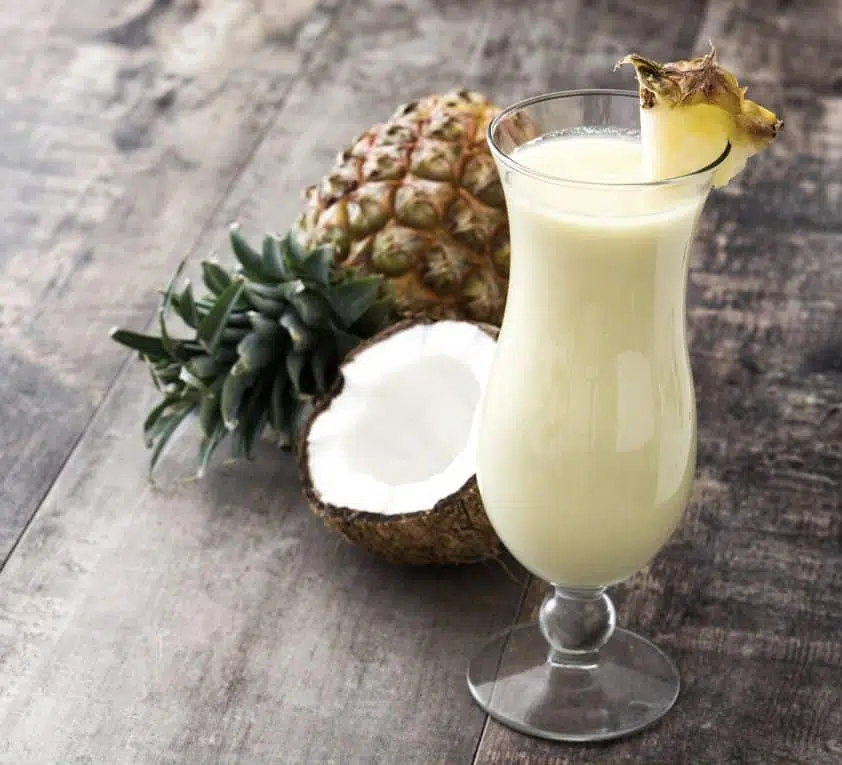
Still, if you want your Piña Colada to be just like you would get it served in Cuba or a good cocktail bar, then there's no shortcut because it needs the combination of low fat and high sugar content.
Cream of coconut is the magical ingredient that brings these tropical cocktails together. Not using it is one reason so many people think they don't like Piña Coladas.
To make this short and sweet: no, unfortunately, you can not interchange those two products. One is meant for cooking, and the other is mostly used for cocktails.
If you can not get cream of coconut in your supermarket, there are only two options. You buy some online or make your own at home. Don't worry. Making homemade cream of coconut is not too difficult, and the result tastes great.
When you compare cream of coconut with coconut milk - as you can see in the table above - you will notice that the fat contents are relatively similar. That is the one factor you cannot change easily.
So by adding sugar to the milk, you can get cream of coconut, whereas if you would add sugar to coconut cream, the fat content would still be far too high.
If your recipe asks for cream of coconut, don't go with a poor replacement. Ideally, you can get it in your local supermarket, or you make it at home.
The Casino Cocktail is one of the lesser-known classic cocktails from the list of IBA cocktails.
Invented by Hugo Ensslin, the gin-forward composition has a genuinely classy touch: Exquisite, sophisticated, and a perfect drink to order in an old-school Casino with a dress code.
Quick Facts Casino Cocktail
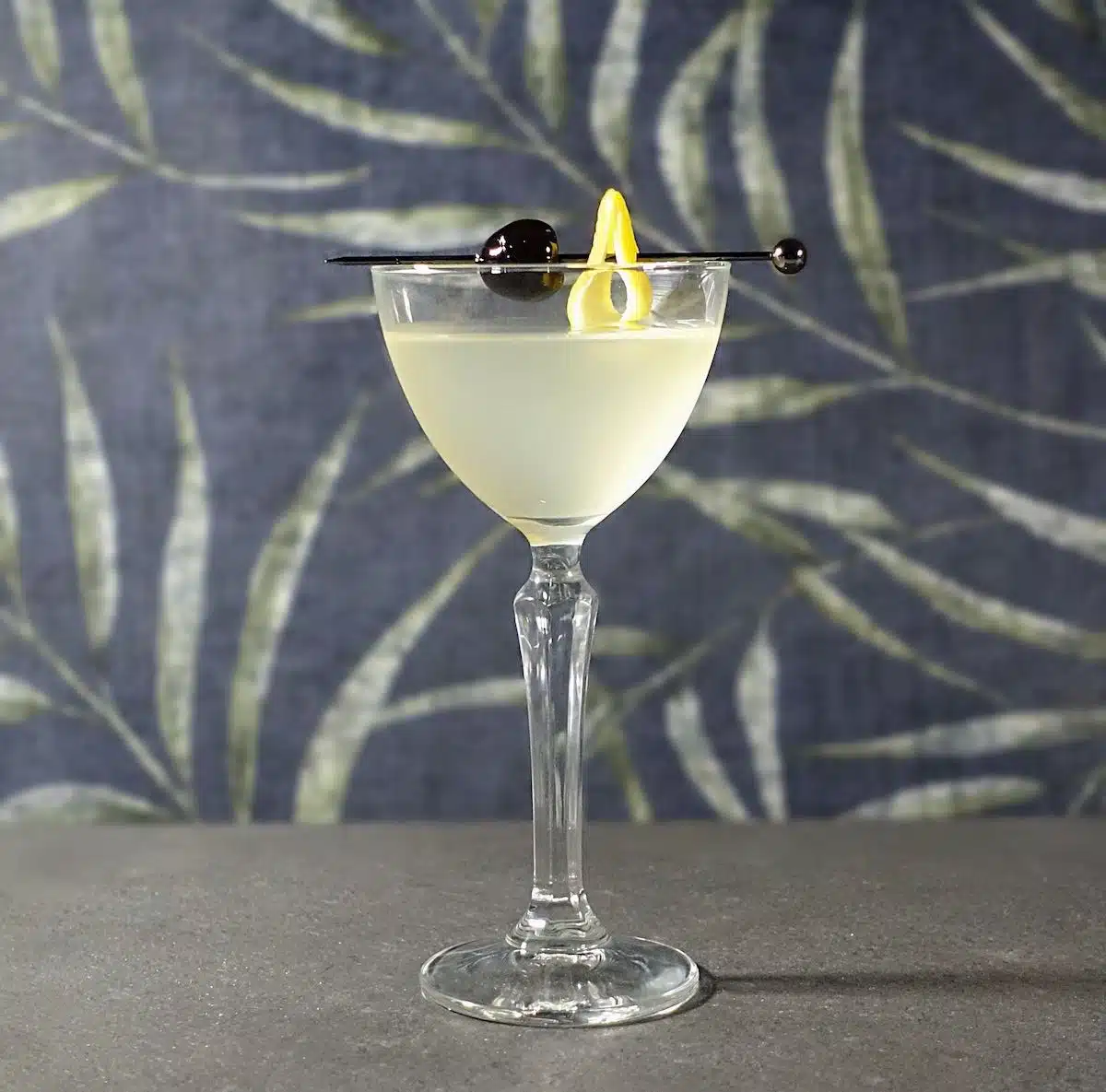
While a lot of recipes opt for the widely available London Dry, and some even use New Western Dry Gins, we prefer to use Old Tom Gin like the original. Why?
For one, if you want to keep a Casino cocktail traditional, you should definitely opt for an Old Tom Gin. It makes a notable difference because it is sweeter than most other gin types.
Usually, the increased level of sweetness is not favorable when it comes to cocktails. In a Casino, however, you need that bit of sugar to achieve a better-balanced result.
Using dry gins or even London Dry Gins often leads to a pretty tart cocktail. That's not necessarily unpleasant -some certainly prefer it that way. But then again, also not how the cocktail is meant to taste.
If you want to use a dry gin after all, consider altering the measurements of the other components in the recipe. Or you can add just a drop or two of simple syrup. -Not more than that, though.
First of all, you should squeeze the lemon juice for the Casino cocktail from fresh and ripe lemons. Only then will you achieve the natural, intense citrus note you need in the drink.
As for the Maraschino liqueur, pick a quality one made with real Marasca cherries. Luxardo is top quality and has been the best-seller for Maraschino liqueur for decades. Yet, other renowned brands like Lazzaroni or Maraska work equally well.
Our preferred choice for orange bitters is the bottle from Angostura. You only need a few drops of these highly concentrated flavor bombs to get a nice orange note into the drink.
For the garnish, you should stick to real Maraschino cherries or something of equal grade, like Amarena cherries. Don't opt for the cheap, neon red candied cocktail cherries - they are basically inedible and a no-go in an elegant classic like the Casino Cocktail.
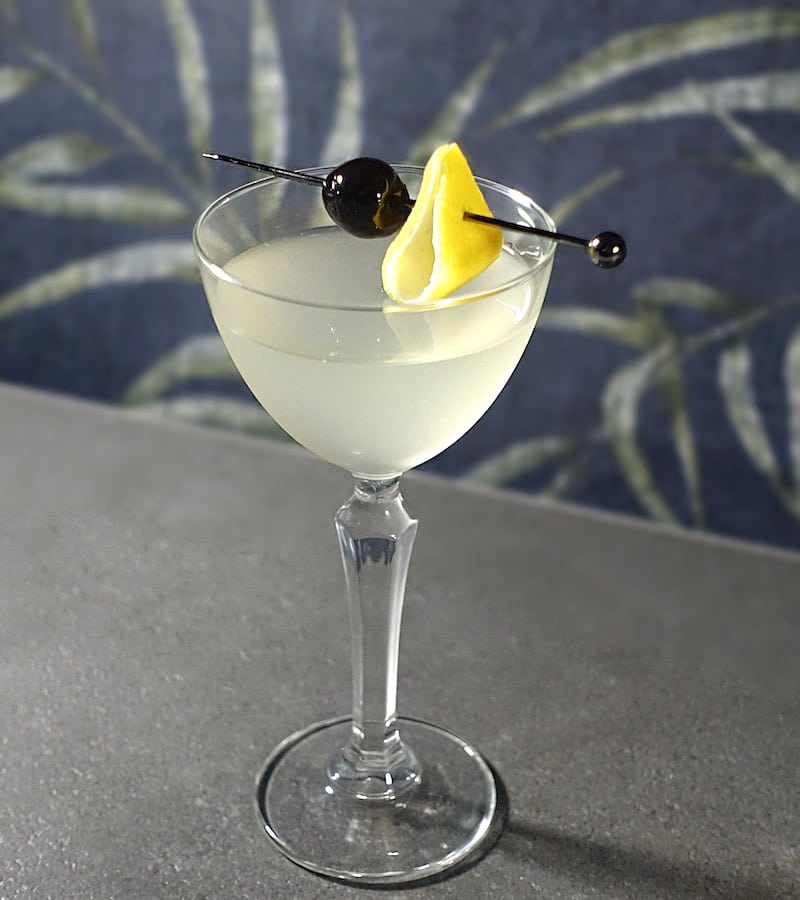
Hugo Ensslin invented the drink while working as a bartender in New York. He included the cocktail recipe in his book Recipes for Mixed Drinks, published in 1917. The original Ensslin recipe was as follows:
As you can see, the ratio between the Old Tom Gin and the other ingredients is pretty hard to assess. Also, Ensslin did not further specify in his book how he measured the ingredients for his drinks. So not knowing exactly how much "one dash" is, in this case, makes it difficult to tell the exact amounts.

What made the Casino Cocktail really famous and turned it to a classic was when Ensslin included it in his Savoy Cocktail Book 13 years later. -A publication that became one of history's most influential cocktail books.
Still, the vague provision of measurements made tweaking and modernizing inevitable. - Not only in terms of ingredients and measurements, but also regarding preparation.
As you can see in the original Casino recipe, the drink used to be stirred, but today, we know that drinks with juices work better when shaken.
Contemporary recipes of the Casino Cocktail sometimes deviate strongly from the original. Over time, numerous other cocktail books included the drink in various interpretations.
For instance, David Embury replaced the orange bitters with orange juice in his take on the Casino cocktail published in his book The Fine Art of Mixing Drinks.
Today's versions are often a mix of the above. Still, we prefer our Casino cocktail closer to the traditional as a mix of Old Tom Gin, Maraschino Luxardo, lemon juice, and orange bitters.
The ratios are slightly different, but the components are the same as in the original.
As you can see from the color, the main difference between an Aviation and Casino cocktail is the addtion of floral Crème de violette.
While the Aviation relies on this purple liqueur to create its iconic color, the Casino doesn't no Crème de violette at all. Instead, orange bitters round up the recipe in the traditional Casino recipe.
Apart from this, the recipes are very similar: they have gin, Maraschino, and lemon in common, and presentation is usually the same: in a Nick & Nora glass with a maraschino cherry.
The Casino Cocktail is part of the Daisy cocktail category. This category comprises drinks all made with a spirit, citrus, and flavored sweetener. Other famous Daisy drinks are
Boulevardier is a French word for a bon vivant. In its most original sense, the term "Boulevardier" describes a man who walks around the boulevards of Paris. It refers to a man about town, someone knowledgeable about the city he lives in and only frequents the most fashionable (Parisian) restaurants, cafés, and bars.
The Boulevardier with Whiskey, Campari, and Vermouth is intended to be a drink that fits that image and as such became quite popular and successful.
Carrying such a thoroughly Parisian name, it's no wonder the Boulevardier Cocktail got invented right there, in the capital of France.
Back in the roaring 1920s, Erskine Gwynne mixed it up for the first time. -Gwynne actually is a Parisian publisher and editor who also founded the French magazine with the name Boulevardier.
He later moved to New York, where he met the renowned Scottish-born bartender Harry MacElhone. MacElhone made the Boulevardier world-famous when he included in his book "Barflies and Cocktails."
The ingredients of a Boulevardier cocktail are pretty similar to a Negroni. Yet, these two drinks couldn't taste more different.
The Boulevardier is a stirred drink based on Whiskey. -As a general rule, cocktails containing only alcocholic components are stirred and not shaken.
While the Negroni usually consists of equal amounts of all ingredients, the Boulevardier has a slightly higher amount of Whiskey to cut through the intense and heavy mix of Campari and Vermouth.
How much of a difference in ratios there is can vary. You can find recipes using 1.25 parts of Whiskey combined with 1 part Sweet Vermouth and 1 part Campari. But you will also come across recipes using two parts Whiskey but keeping the ratios for Vermouth and Campari.
My preferred ratio is 1.5 parts of Whiskey. That is enough Whiskey to cut through Campari and sweet Vermouth without overdosing on it. But don't be afraid of experimenting a bit to find the right balance for you.
As with every three-ingredient cocktail, quality is key. So besides the bittersweet, herbal Campari, you want to use a quality Sweet Vermouth (my favorite is Antica Formula) and a great Whiskey.
Which type of Whiskey is ultimately up to you. So, if you have a favorite that's not overly smoky, you can always use that. If you don't, I recommend using the classic in this recipe: Bourbon.
The vanilla, oak, and caramel notes of the native American Whiskey is beautiful in a Boulevardier as it creates a rounder version of the drink. Rye Whiskey is also a good choice, which results in a slightly spicier version of the cocktail.
Both cocktails are based on a vibrant mix of Sweet Vermouth and Campari. Those two ingredients bring in tons of flavor, bitterness, and sweetness.
Yet, when using Gin to make a classic Negroni, you get this beautifully crisp summer drink: Refreshing, sweet, bitter, and herbal. A great sip to relax on a warm afternoon.
It's interesting how, just by adding Whiskey instead of Gin, you get a completely different drink. It creates a rich and warming cocktail that feels more suitable for a rough and cold day in autumn or winter.
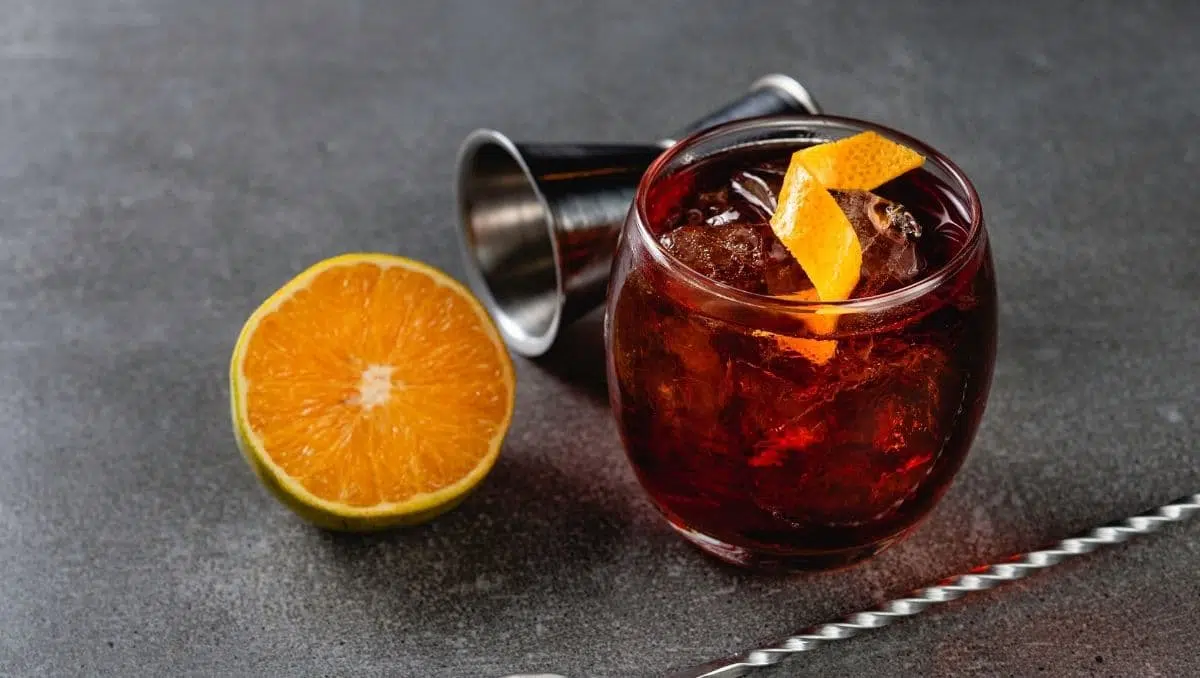
Initially, the limited Samurai Edition of Nikka Gold and Gold with the black label was a Tokyo travel retail exclusive available at limited Japanese duty-free locations, which made it a sought-after rarity. - The only places you could get it were Haneda and Narita airports, both located in Japan's capital.
Protected by a metal-clad samurai armour, the bottle contains the gold and gold expression. This blended whisky is produced from several nikka expressions and has a thin body with a well-balanced flavor profile.
For rarities like the Nikka Gold & Gold Samurai edition, you can expect to pay up to a couple of hundred dollars. So let's move to the review and see if the expression is actually worth it.
The subtle nose is comparably mild with fruity and fresh aromas, vanilla sweetness, strong caramel notes, warm spices in the background, and soft perfume notes. You can also detect some floral notes in the background and hints of green mint.
Despite the low proof of Nikka's Gold & Gold expression, you can also detect some subtle hints of ethanol.
The overall light palate of the whisky combines the flavors of malt whiskies with grain notes with more floral notes and sweet vanilla and caramel flavors. Winter mint notes, pine, and citrus flavors create a nice balance to the sweet flavors.
The result is a smooth overall palate with mild spice levels and a balanced blend of flavors. The spirit is refreshingly light and thin compared to other nikka expressions I tried before. However, I can imagine this whisky is great in refreshing summer whisky cocktails like a Whisky & Soda aka Japanese Highball.
A short and sweet finish rounds off the flavor profile. The fresh herbal notes and grassy flavors are complemented by a splash of bitterness from black tea. At the very end, an earthy note paired with a slight burn from the alcohol leads to a dry and minty note lingering on the palate.
It's a decent whisky to drink neat, but nothing outstanding. It's also a nice fit for a whiskey cocktail, but on the other hand, you can get more affordable options for use in mixed drinks.
Overall, I would definitely drink this Nikka Gold and Gold special edition again, but it's not what I would order or keep in my home bar.
The limited release of Gold & Gold comes in a samurai suit inside a presentation box. The unique and unusual bottle presentation with its removable samurai armour and its own metallic samurai helmet, make this bottle the ultimate decorative piece on your whiskey shelf.
In fact, this collectible nikka blend is very similar to the original version released in 1968. Even the black label is almost identical to the nikka samurai gold and gold bottle today.
Nikka Gold and Gold is a blended Japanese Whisky made from several Nikka expressions aged in different casks. To create this blended whisky, Nikka uses blended grain and malt whiskies of varying ages.
The thin body and overall light flavor profile make me guess that the whiskies used for the blend didn't age for too long. However, Nikka doesn't give any first-hand information about the aging.
The whisky in the Nikka Gold & Gold Samurai edition is produced at the Yoichi and Miyagikyo distilleries. Nestled in Sendai, northern Japan, the Miyagikyo Distillery was thoughtfully chosen for its pristine air, optimal humidity, and abundant underground peat-filtered water. This serene location, embraced by mountains and rivers, captured Masataka Taketsuru's vision, reminiscent of Scotland. Here, the distilled whisky gains a gentle and soft character, echoing the purity of its surroundings.
The Yoichi Distillery, founded by the father of Japanese whisky and Nikka founder Masataka Taketsuru in 1934, brings the essence of the Scottish highlands to Hokkaido's town of Yoichi. Taketsuru's extensive study of Scotch whisky production inspired this establishment. Visitors can tour the vast grounds, which include original stone buildings and his former home. Guided tours in Japanese or downloadable English audio guides provide insight into the distillation process and Taketsuru's legacy.
The Samurai edition with its removable samurai armor looks quite unique and is very different from the standard bottle design, but it is not the first time Nikka has been selling it. In fact, Nikka's Gold and Gold Samurai edition was launched originally in 1968 and is one of the mainstays of Nikka's range. However, only a couple of years later, it was discontinued again during the 1970s.
The bottle design of the Samurai commander came back when Nikka decided to produce this limited edition version. I cannot tell exactly when that was, but it was some years ago already.
With the Samurai armor, they tried to sell it to tourists for a higher price. That's also why it's exclusively sold at the two airports Narita and Haneda. -And that strategy worked.
The bottle it comes in is called "Shirobin" (Japanese for "white bottle"), and it does the job. The design of the label is very similar to the initial version from 1968. Even if you're not a fan of whisky, this extravagant bottle design looks great on the bar shelf. - By the way, the Samurai armor is solid and quite heavy, and you better remove it before pouring your drink.
What's also very interesting is that the Nikka Gold and Gold Whisky has traditionally been a budget whisky and of lower quality than other Nikka whisky. It's the bottle design and the availability that set the price.
If you buy a bottle at the airport, you will pay between $40-$60, depending on the location and special promotions. That's not an irresistible bargain, but considering the quality and the unique design, it's fair.
If you try to buy this bottle online, you will see prices on the secondary market range from $80 to $500. -The right time for a reminder that this is a budget version of Nikka Whisky, and the quality is not as high as, for instance, that of their Nikka Coffey Grain. Your money might be better invested elsewhere.
The light and mild flavor profile of Nikka Gold and Gold, driven by maltiness and sweet flavors like vanilla and caramel and complemented by soft sweet spices, make this expression an ideal ingredient in light whiskey cocktails.
Here are some cocktail recipes and how Nikka Gold & Gold whiskey complements each one:
The whisky itself is not worth the high price point. It's by no means a bad whisky, but too expensive for what you get. Depending on your point of view, the packaging alone could be worth it, though.
The Samurai armor on the bottle will definitely stand out on your bar shelf. If you can get it at a reasonable price, it will make for a visually striking addition to your collection.